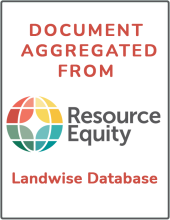Land Library Search
Through our robust search engine, you can search for any item of the over 73,000 highly curated resources in the Land Library.
If you would like to find an overview of what is possible, feel free to peruse the Search Guide.
/ library resources
Showing items 1 through 9 of 142.Post-Soviet reforms in Kyrgyzstan during the 1990s and early 2000s included the allocation of land for long time use and eventual ownership to residents. 75% of arable land, including over 1 million hectares of agriculture land was distributed during this period.
Digital technologies cut off access to land
Despite promises to fix unjust land governance, a new study shows that digital technologies can further land grabbing and inequality.
The concept of sustainable livelihood garnered a prominent status in humanitarian and international development organizations that aim to calculate and build a livelihood for agroforestry farmers.
Through structured comparison, this article seeks to present the different approaches to urban agriculture in the cities of Singapore and Kigali. The former is seen as a model ‘smart city’ worth following worldwide, while the latter is frequently referred to as the ‘Singapore of Africa’.
In 2021, the Biden administration signed an executive order to protect 30% of American lands by 2030. Accomplishing this ambitious goal in the U.S. requires understanding the relative contribution of public and private lands toward supporting biodiversity.
Global land ownership patterns have been shifting in recent decades, as institutional and non-traditional investors redirect capital into rural areas. Such investment is a stimulating alternative for innovative profit-driven land uses that move beyond agriculture.
Tension and conflict are endemic to any upgrading initiative (including basic infrastructure provision) requiring private land contributions, whether in the form of voluntary donations or compensated land acquisitions.
Despite the economic and social costs of national and international efforts to restore millions of hectares of deforested and degraded landscapes, results have not met expectations due to land tenure conflicts, land-use transformation, and top-down decision-making policies.
Research Highlights: We used airborne lidar to assess the multi-scalar patterns of forest structure across a large (471,000 hectare), multi-owner landscape of the Oregon Coast Range, USA.








